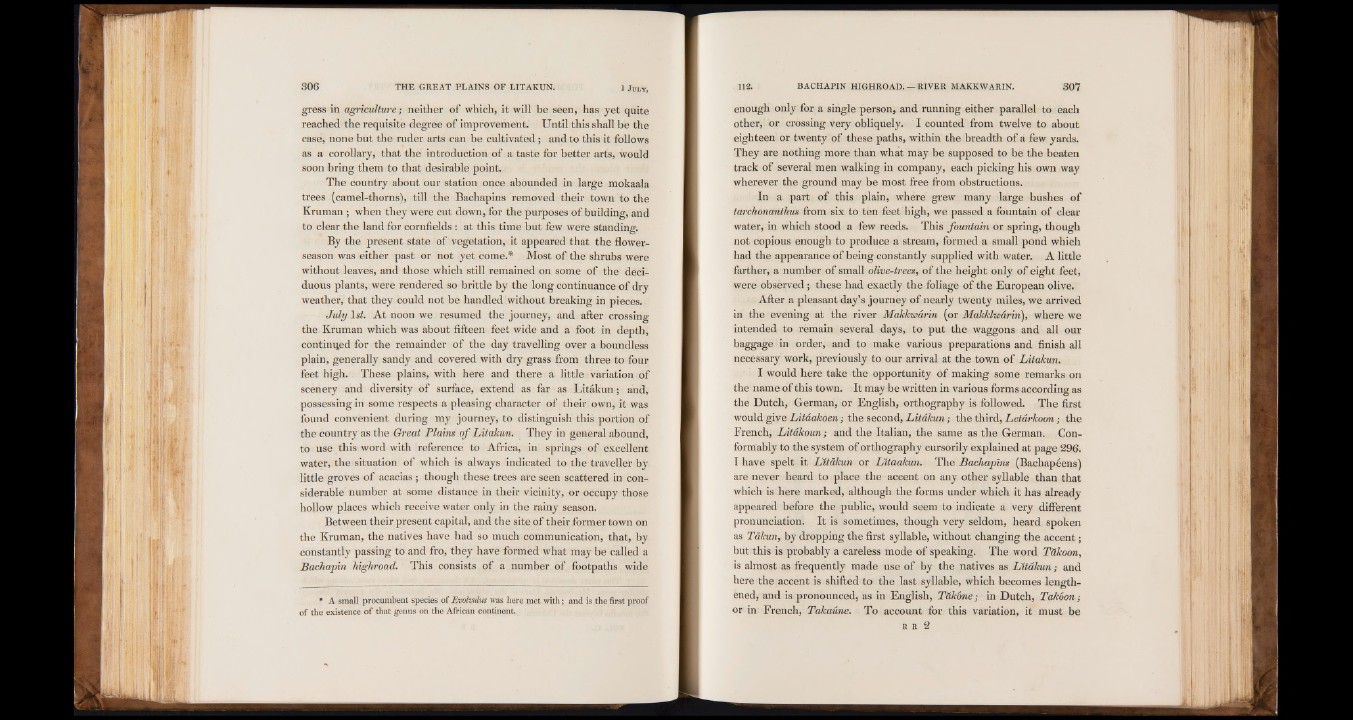
306 THE GREAT PLAINS OF LITAKUN. 1 J u l y ,
gress in agriculture; neither of which, it will be seen, has yet quite
reached the requisite degree of improvement. Until this shall be the
case, none but the ruder arts can be cultivated; and to this it follows
as a corollary, that the introduction of a taste for better arts, would
soon bring them to that desirable point.
The country about our station once abounded in large mokaala
trees (camel-thorns), till the Bachapins removed their town to the
Kruman ; when they were cut down, for the purposes of building, and
to clear the land for cornfields : at this time but few were standing.
By the present state of vegetation, it appeared that the flower-
season was either past or not yet come.* Most of the shrubs were
without leaves, and those which still remained on some of the deciduous
plants, were rendered so brittle by the long continuance of dry
weather, that they could not be handled without breaking in pieces.
July 1st. At noon we resumed the journey, and after crossing
the Kruman which was about fifteen feet wide and a foot in depth,
continued for the remainder of the day travelling over a boundless
plain, generally sandy and covered with dry grass from three to four
feet high. These plains, with here and there a little variation of
scenery and diversity of surface, extend as far as Litakun; and,
possessing in some respects a pleasing character of their own, it was
found convenient during my journey, to distinguish this portion of
the country as the Oreat Plains of Litakun. They in general abound,
to use this word with reference to Africa, in springs of excellent
water, the situation of which is always indicated to the traveller by
little groves of acacias ; though these trees are seen scattered in considerable
number at some distance in their vicinity, or occupy those
hollow places which receive water only in the rainy season.
Between their present capital, and the site of their former town on
the Kruman, the natives have had so much communication, that, by
constantly passing to and fro, they have formed what may be called a
Bachapin highroad. This consists of a number of footpaths wide
* A small procumbent species of Evolvulus was here met with; and is the first proof
of the existence of that genus on the African continent.
112. BACHAPIN HIGHROAD. — RIVER MAKKWARIN. 307
enough only for a single person, and running either parallel to each
other, or crossing very obliquely. I counted from twelve to about
eighteen or twenty of these paths, within the breadth of a few yards.
They are nothing more than what may be supposed to be the beaten
track of several men walking in company, each picking his own way
wherever the ground may be most free from obstructions.
In a part of this plain, where grew many large bushes of
tarchonanthus from six to ten feet high, we passed a fountain of clear
water, in which stood a few reeds. This fountain or spring, though
not copious enough to produce a stream, formed a small pond which
had the appearance of being constantly supplied with water. A little
farther, a number of small olive-trees, of the height only of eight feet,
were observed; these had exactly the foliage of the European olive.
After a pleasant day’s journey of nearly twenty miles, we arrived
in the evening at the river Makkwarin (or Makklwarin), where we
intended to remain several days, to put the waggons and all our
baggage in order, and to make various preparations and finish all
necessary work, previously to our arrival at the town of Litakun.
I would here take the opportunity of making some remarks on
the name of this town. It may be written in various forms according as
the Dutch, German, or English, orthography is followed. The first
would give Litaakoen; the second, Litakun; the third, Letarkoon; the
French, Litdkoun; and the Italian, the same as the German. Conformably
to the system of orthography cursorily explained at page 296.
I have spelt it Litakun or Litaakun. The Bachapins (Bachapeens)
are never heard to place the accent on any other syllable than that
which is here marked, although the forms under which it has already
appeared before the public, would seem to indicate a very different
pronunciation. It is sometimes, though very seldom, heard spoken
as Takun, by dropping the first syllable, without changing the accent;
but this is probably a careless mode of speaking. The word Tdkoon,
is almost as frequently made use of by the natives as Litakun; and
here the accent is shifted to the last syllable, which becomes lengthened,
and is pronounced, as in English, T d k o n e in Dutch, Takoon;
or in French, Takaune. To account for this variation, it must be
Ii a 2